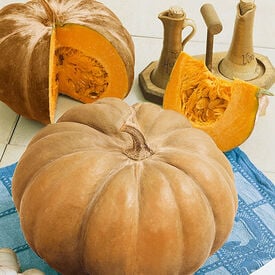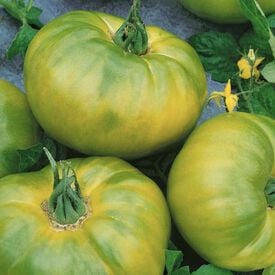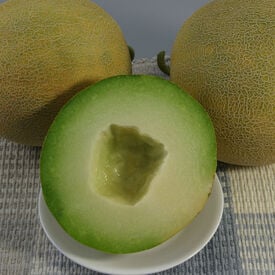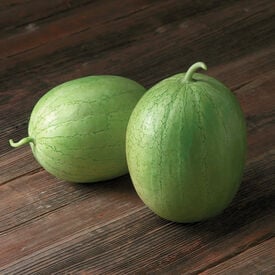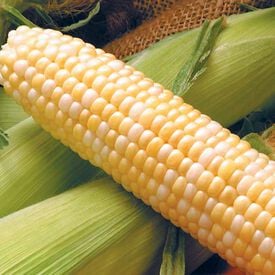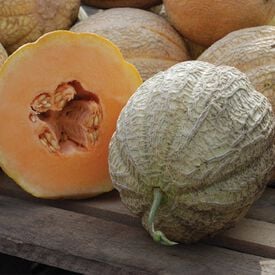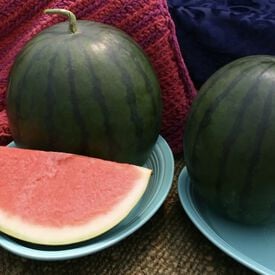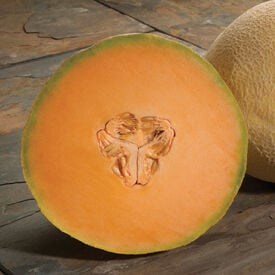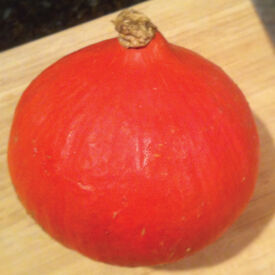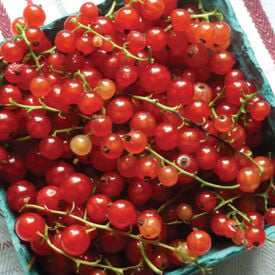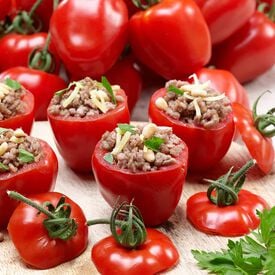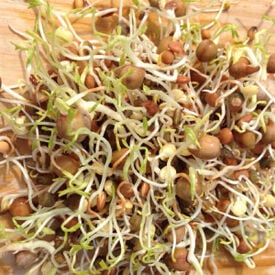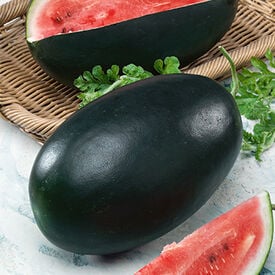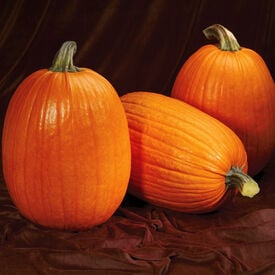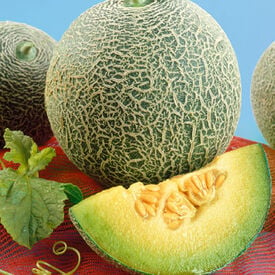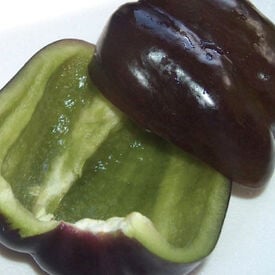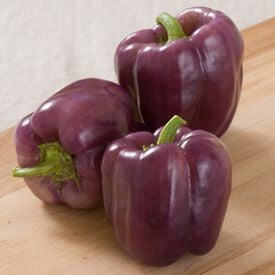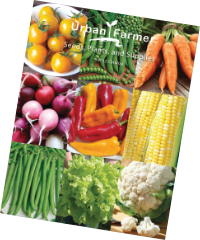The Autumn Buckskin F1 Pumpkin is a buff colored dickenson hybrid that was selected especially for both baking and decorative purposes. This slightly flattened, hardy pumpkin is 8 x 13 inches big weighing at 12-15 pounds! This plant has large vines to produce up to 5 pumpkins per plant.
Chef's Choice Green Tomatoes are a delightful and unique variety of tomatoes known for their vibrant green color and exceptional flavor. These tomatoes have a fascinating history rooted in the world of culinary innovation. Developed by renowned tomato breeder Brad Gates, the Chef's Choice series was created to provide chefs and home gardeners with a range of exceptional tomato varieties. The green version, Chef's Choice Green, stands out for its outstanding qualities. Chef's Choice Green Tomatoes typically grow to a medium to large size, with fruit that can reach diameters of 3 to 4 inches (7.5 to 10 centimeters). They have a slightly flattened, beefsteak-like shape, which is ideal for slicing and adding to salads or sandwiches. The tomatoes are known for their rich, complex flavor, balancing a sweet and tangy taste with a hint of earthiness, making them a versatile choice for culinary creations. The plants that produce Chef's Choice Green Tomatoes are indeterminate, meaning they continue to grow and produce fruit throughout the growing season. They are known for their vigorous growth, often reaching heights of 6 to 8 feet (1.8 to 2.4 meters) or more, depending on growing conditions. These plants thrive in warm climates with plenty of sunlight and well-drained soil. Adequate support and pruning may be necessary to manage their size and ensure healthy fruit production. Overall, Chef's Choice Green Tomatoes are a fantastic addition to any garden, offering a unique and delicious twist on traditional tomato varieties.
A Galia type melon with great resistance to powdery mildew resistance. Produces an abundance of 5-6lb. melons on vigorous vines. Thick, aromatic, sweet green flesh of excellent eating quality. Small seed pocket. Harvest at full slip, when the skin of the fruit is yellow.
For use with seedless watermelon production. Ace was developed as a non-harvested pollenizer for the production of seedless watermelon. It produces long, thin and very sturdy vines with small leaves. Ace blooms early and profusely, providing an abundance of pollen over a more extended period.
Providence corn is one of our favorite corns to grow for market use! This corn is a TripleSweet bicolor sweet corn with excellent eating quality that is suited for roadside and farm market sales. The husk package is medium green with moderate flags and covers the tip well. We're sure that this corn is going to be your's or your customer's favorite!
Schoon's Hardshell melon is a large heirloom favorite! This big melon can weigh 5-8 pounds. The slow to ripen thick gray-green skin has a highly flavored orange flesh. The flavor is very sweet and will maintain the taste and texture for long after being harvested. Certified Organic. Learn more about our organic seeds.
Sorbet is a delicious and small sized watermelon that is great for farmers markets and home gardens. Matures to 6-8lbs, 9" round with crisp and bright red flesh. Great flavor and lots of sweetness. Needs a pollinator watermelon variety like Sugary Baby. Intermediate resistance to Fusarium wilt race 0 and anthracnose.
Atlantis is an Eastern melon with a round-oval shape. It has excellent interior qualities, including firmness and consistently high sugar content for high consumer appeal. Atlantis can be used for home gardens or farm market variety. Excellent field performance
The Red Kuri is a delicious red and uniquely shaped Japanese winter squash. This variety matures small fruits that reach to be 10 lbs. each with a slight teardrop-shape. The Red Kuri has a smooth golden flesh that is dry, sweet and rich. This squash is a great yielding and keeping variety.
Red Currant tomatoes are a charming heirloom variety renowned for their tiny, jewel-like fruits and exceptional sweetness. Believed to have origins in both Europe and North America, this variety has been cherished for its prolific nature and unique characteristics. The tomatoes are notably small, often the size of a pea, and grow in clusters reminiscent of currants, hence the name. They are bright red when ripe and possess a delightful, tangy-sweet flavor that makes them perfect for snacking, salads, and garnishes. Red Currant tomatoes typically reach maturity in about 60 to 70 days, making them relatively quick to harvest. The plants exhibit a vigorous, indeterminate growth habit, meaning they produce an abundant yield throughout the growing season and require staking or caging to manage their sprawling vines. With their vibrant color, sweet flavor, and impressive productivity, Red Currant tomatoes are a favorite among gardeners looking to add both beauty and a burst of flavor to their gardens.
Great stuff ’n tomato with a nearly hallow core to create your own delicious snacks. The flat bottom gives the tomato a stable base during preparation.
Mini Love watermelon seeds are a delightful choice for gardeners seeking to grow sweet, bite-sized watermelons. These compact melons typically reach around 5 to 7 pounds, making them perfect for small families or for enjoying as a refreshing snack. With their vibrant green rind and juicy, pink flesh, Mini Love watermelons are not only visually appealing but also packed with flavor, boasting a sweet and crisp texture that is sure to please. They thrive in warm climates and require full sun, making them suitable for backyard gardens, raised beds, or even containers on patios. With a growing season of approximately 75 to 80 days, these watermelons yield an impressive harvest, ensuring you have plenty to enjoy during the hot summer months. Whether sliced for a picnic, blended into smoothies, or served at gatherings, Mini Love watermelons are a fun and tasty addition to any garden. All American Winner selection.
This beautiful Bean Mix is a mixture of great tasting, pastel colored seeds! The Bean Mix includes Green, Crimson & Red Chief Lentils, Green, Marrowfat & Yellow Peas, Beige Garbanzos and Adzukis. This sprout mix is great for snacking or dressing up a salad. Time to Sprout: 4-5 Days Flavor: Crunchy and mouth watering. Nutrition: Vitamins A, B, C, & E, Calcium, Iron, Magnesium, Niacin, Phosphorous, & Potassium, Protein: 25%
The Nobility F1 Watermelon is a hybrid of the old, favorite standard picnic type and is the diploid, the seeded version, of the Triple Picnic variety. This fan favorite has a very firm flesh and an extra sweet flavor that is perfect on a hot summer day. The dark green almost black rind is nearly sunburn resistant and thrives in warm, humid climates.
Captain Jack is an extra-large, dark orange Jack O’Lantern-type pumpkin. Its thick flesh and flat bottom enables the fruit to stand on its own. Extremely large, thick embedded handles match the large size of this pumpkin. Large and vigorous plants can support several fruit. Grows to 35-45lbs. in size.
The deep fine grained green flesh of the Rocky Ford Green Flesh has a crisp, fresh taste. This small melon is 5.5x5" diameter, weighing 2-3 lbs. Rocky Ford Green Flesh's skin has a heavy net that is slightly ribbed. Overall, this cantaloup is very rust resistant, prolific, and good for home gardens and local markets. This melon is also good shipper.
The Purple Beauty Pepper is a productive pepper plant that produces attractive deep purple colored peppers! This pepper is an open-pollinated variety with a sweet tasting 3x3" block shaped peppers. Pick when the pepper is purple or wait for it to turn deep red when its mature, which happens later in the season. The Purple Beauty is a great pepper for container gardening and can add that extra kick to your salads or meals.
The Islander Pepper is known as the chameleon as it is beautiful pepper to watch its colorful display! This color-crazy pepper starts out as a violet hue, then turns to a yellow/orange and then finally deep red! This variety can be picked at any of these stages to provide awesome color to salads and meals. The Islander is a thick-fleshed, medium-sized bell pepper with 3-lobes that have a mild, slightly sweet taste. This colorful pepper also has a resistance to tobacco mosaic virus.
